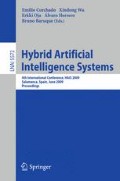Abstract
Software architectures for agent technology and robots have been polarized between reactive architectures and architectures based on planning and reasoning. Although hybrid architectures have been shown to offer benefits from both, these seem complicated to integrate. In this paper we integrate the reactive nature of finite state machines and the reasoning capabilities of non-monotonic logics to produce intelligent autonomous robots. In particular, we demonstrate this with a robotic poker player. The robotic player integrates vision, sound recognition, motion control and the reasoning to perform competitively as a player in a complex game with incomplete information.
Access this chapter
Tax calculation will be finalised at checkout
Purchases are for personal use only
Preview
Unable to display preview. Download preview PDF.
References
Wichert, G.V., Lawitzky, G.: Man-machine interaction for robot applications in everyday environments. In: IEEE Int. Workshop on Robot and Human Interactive Communications, Bordeaux, Paris, pp. 343–346 (2001)
Clarkson, J., Dowland, B., Cipolla, R.: The use of prototypes in the design of interactive machines. In: Int. Conf. Engineering Design ICED 1997, Tampere (1997)
Tzafestas, S., Tzafestas, E.: Human-Machine interaction in intelligent robotic systems: A unifying consideration with implementation examples. J. Intelligent and Robotic Systems 32(2), 119–141 (2001)
Breazeal, C., Takanishi, A., Kobayashi, T.: Social robots that interact with people. Springer Handbook of Robotics, pp. 1349–1369. Springer, Berlin (2008)
Sankar, N. (ed.): Human-Robot Interaction. I-Tech Education, Vienna (2007)
Vassos, S., Levesque, H.: Progression of situation calculus action theories with incomplete information. In: 20th IJCAI, Hyderabad, India, pp. 2024–2029 (2007)
Trevizan, F.W., de Barros, L., Corrêa da Silva, F.: Designing logic-based robots. Inteligencia Artificial 10(31), 11–22 (2006)
Antoniou, G.: Nonmonotonic Reasoning. MIT Press, Cambridge (1997)
Billington, D., Rock, A.: Propositional plausible logic: Introduction and implementation. Studia Logica 67, 243–269 (2001)
Rock, A., Billington, D.: An implementation of propositional plausible logic. In: 23rd Australasian Computer Science Conf. of Australian CSC, vol. 22(1), pp. 204–210 (2000)
Billington, D.: The proof algorithms of plausible logic form a hierarchy. In: Zhang, S., Jarvis, R. (eds.) AI 2005. LNCS (LNAI), vol. 3809, pp. 796–799. Springer, Heidelberg (2005)
Billington, D., Estivill-Castro, V., Hexel, R., Rock, A.: Plausible logic facilitates engineering the behavior of autonomous robots (submitted)
Xin, M., Sharlin, E.: Playing games with robots — a method for evaluating human-robot interaction. In: Sankar, N. (ed.) Human-Robot Interaction, Vienna, Austria, ch. 26, pp. 469–480. I-Tech Education and Publishing (2007)
Schiffel, S., Thielscher, M.: Fluxplayer: A successful general game player. In: Twenty-Second AAAI Conf. on Artificial Intelligence, pp. 1191–1196. AAAI Press, Menlo Park (2007)
Lovell, N.: Machine Vision as the Primary Sensory Input for Mobile, Autonomous Robots. PhD thesis, School of ICT, Griffith University, Nathan, QLD (2006)
Estivill-Castro, V., Seymon, S.: Mobile robots for an e-mail interface for people who are blind. In: Lakemeyer, G., Sklar, E., Sorrenti, D.G., Takahashi, T. (eds.) RoboCup 2006: Robot Soccer World Cup X. LNCS, vol. 4434, pp. 338–346. Springer, Heidelberg (2007)
Wooldridge, M.: An Introduction to MultiAgent Systems. John Wiley, NY (2002)
Liu, T.X.W., Baltes, J.: An intuitive and flexible architecture for intelligent mobile robots. In: 2nd Int. Conf. Autonomous Robots and Agents, NZ, pp. 52–57 (2004)
Larman, C.: Applying UML and Patterns: An Introduction to Object-Oriented Analysis and Design and Iterative Development. Prentice-Hall, NJ (1995)
Jeffries, D., Anderson, A., Hendrickson, C.: Extreme Programming Installed. Addison-Wesley, MA (2001)
Compton, P., et al.: Ripple down rules: possibilities and limitations. In: 6th Banf AAAI Knowledge Acquisiiton for Knowledge Based Systems Workshop (1991)
Heintz, F., Rudol, P., Doherty, P.: Bridging the sense-reasoning gap using dyknow: A knowledge processing middleware framework. In: Hertzberg, J., Beetz, M., Englert, R. (eds.) KI 2007. LNCS, vol. 4667, pp. 460–463. Springer, Heidelberg (2007)
Gamma, E., Helm, R., Johnson, R., Vlissides, J.: Design Patterns: Elements of Reusable Object-Oriented Software. Addison-Wesley, MA (1995)
Kim, J.H., Lee, K.H., Kim, Y.D.: The origin of artificial species: Generic robot. Int. J. Control, Automationa, and Systmes 3(4), 564–570 (2005)
Hayes-Roth, B.: A blackboard architecture for control. In: Distributed Artificial Intelligence, pp. 505–540. Morgan Kaufmann, San Francisco (1988)
Rumbaugh, J.R., Blaha, M.R., Lorensen, W., Eddy, F., Premerlani, W.: Object-Oriented Modeling and Design. Prentice-Hall, NJ (1991)
Billington, D., Estivill-Castro, V., Hexel, R., Rock, A.: Non-monotonic reasoning for localisation in robocup. In: Australasian Conf. on Robotics and Automation, Sydney, Australian Robotics and Automation Association (2005)
Billington, D., Estivill-Castro, V., Hexel, R., Rock, A.: Using temporal consistency to improve robot localisation. In: Lakemeyer, G., Sklar, E., Sorrenti, D.G., Takahashi, T. (eds.) RoboCup 2006: Robot Soccer World Cup X. LNCS, vol. 4434, pp. 232–244. Springer, Heidelberg (2007)
Billington, D., Estivill-Castro, V., Hexel, R., Rock, A.: Non-monotonic reasoning on board a sony AIBO. In: Lima, P. (ed.) Robotic Soccer, ch. 3, Vienna, Austria, pp. 45–70. I-Tech Education and Publishing (2007)
Brooks, R.: Intelligence without reason. In: 12th ICJAI, Sydney, Australia, pp. 569–595. Morgan Kaufmann, San Francisco (1991)
Brooks, R.: How to build complete creatures rather than isolated cognitive simulators. In: Architectures for Intelligence, pp. 225–239. Lawrence Erlbaum, Mahwah (1991)
Author information
Authors and Affiliations
Editor information
Editors and Affiliations
Rights and permissions
Copyright information
© 2009 Springer-Verlag Berlin Heidelberg
About this paper
Cite this paper
Billington, D., Estivill-Castro, V., Hexel, R., Rock, A. (2009). Architecture for Hybrid Robotic Behavior. In: Corchado, E., Wu, X., Oja, E., Herrero, Á., Baruque, B. (eds) Hybrid Artificial Intelligence Systems. HAIS 2009. Lecture Notes in Computer Science(), vol 5572. Springer, Berlin, Heidelberg. https://doi.org/10.1007/978-3-642-02319-4_18
Download citation
DOI: https://doi.org/10.1007/978-3-642-02319-4_18
Publisher Name: Springer, Berlin, Heidelberg
Print ISBN: 978-3-642-02318-7
Online ISBN: 978-3-642-02319-4
eBook Packages: Computer ScienceComputer Science (R0)

